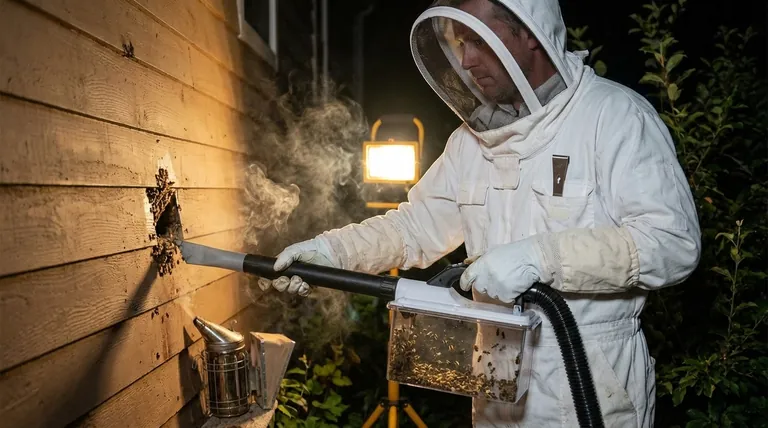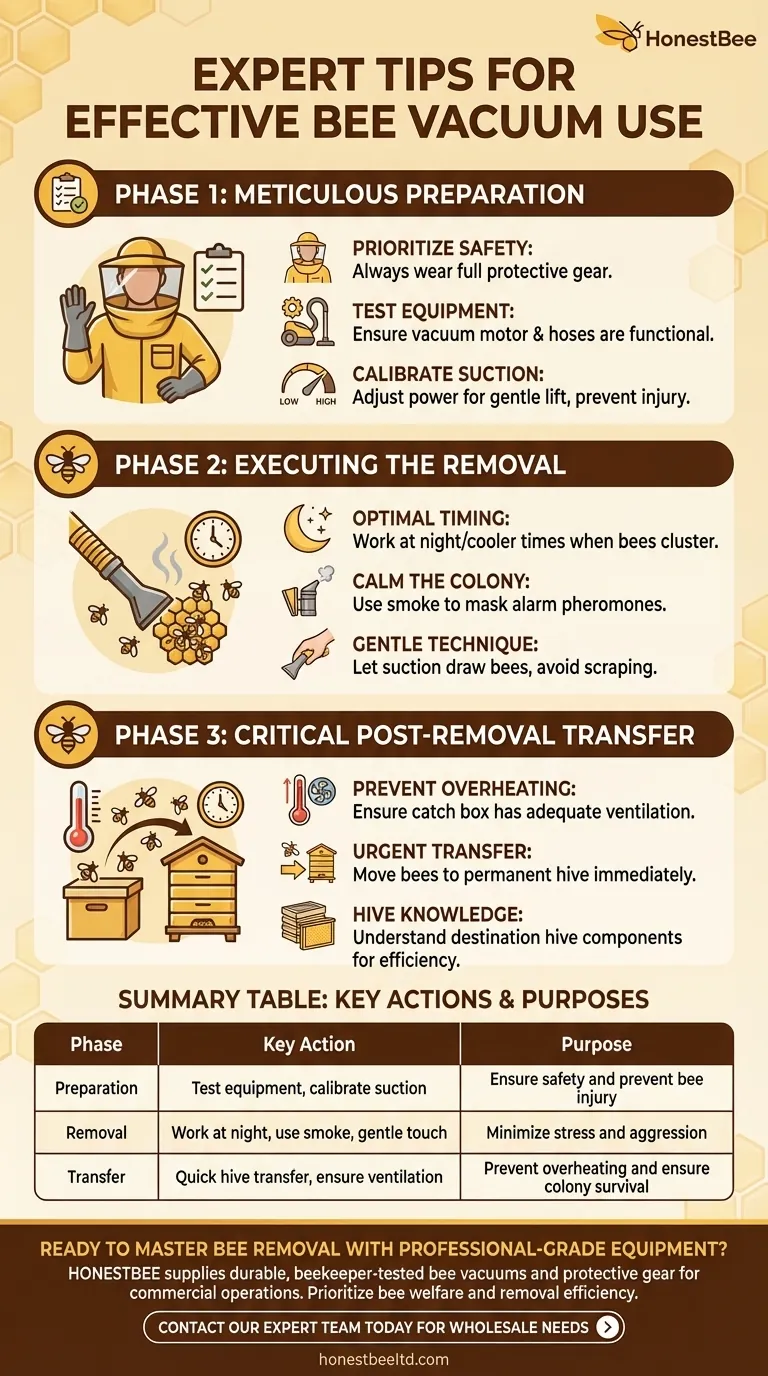To use a bee vacuum effectively, you must combine the right technique with a deep respect for the bees' well-being. The core principles involve wearing full protective gear, using smoke to calm the colony, working at night when bees are less active, and carefully managing the vacuum's suction to prevent injury. A successful removal depends on moving the bees quickly from the vacuum into their new hive to prevent them from overheating.
A bee vacuum is not just a tool for removal; it's a temporary life support system. Your primary goal is to minimize stress and injury to the colony by carefully controlling suction, heat, and the duration of the process.

The Three Phases of a Successful Removal
A bee vacuum removal is a delicate operation that can be broken down into three critical stages: preparation, the removal itself, and the final transfer. Excelling at each stage is crucial for the colony's survival.
Phase 1: Meticulous Preparation
Prioritize Your Safety Even with a vacuum, you are dealing with a defensive bee colony. Always wear a full bee suit, including a veil and gloves, to prevent stings.
Test Your Equipment Thoroughly Before you begin, perform multiple tests to ensure your vacuum is working correctly. Check that the motor runs smoothly and that all hoses are securely connected and free of obstructions.
Calibrate the Suction The most common mistake is using excessive suction, which will kill the bees. Your vacuum should have a relief gate or variable speed control. Adjust it so it has just enough power to gently lift the bees into the hose without slamming them against the catch box.
Phase 2: Executing the Removal
Work at Night if Possible Bees are calmer and clustered together in their hive at night or during cooler weather. Working during these times makes the removal process more efficient and reduces the number of defensive bees in the air.
Use Smoke to Calm the Colony Gently puff smoke at the entrance and into the cavity before you begin. Smoke helps mask the bees' alarm pheromones, which they release to signal danger, making the colony significantly less aggressive.
Vacuum with a Gentle Touch Hold the nozzle a short distance away from the bees. Let the suction draw them in rather than scraping them off the comb. Work slowly and methodically, clearing one section at a time.
The Critical Post-Removal Transfer
Once the bees are in the vacuum's catch box, the clock is ticking. This phase is just as important as the removal itself.
The Danger of Overheating
A large mass of agitated bees in a confined space generates an incredible amount of heat. If left in the catch box for too long, they can quickly overheat and perish. The box must have adequate ventilation.
Transfer the Bees Without Delay
You must move the bees into their permanent hive as soon as the removal is complete. A quick transfer allows them to spread out, regulate their temperature, and access any food and water you have provided.
Understand Your Hive Components
Being familiar with the components of the destination hive (frames, foundation, feeders) is essential. This knowledge allows you to perform the transfer efficiently, minimizing the time the bees spend in a stressful, confined state.
How to Apply This to Your Goal
- If your primary focus is a structural removal (bees in a wall): Your goal is patience. Work slowly, manage your suction carefully, and be prepared for a multi-hour job to ensure you get as much of the colony and comb as possible.
- If your primary focus is capturing an exposed swarm: Gentleness is key. Swarms are typically docile, so use the absolute minimum suction required to draw them into the catch box.
- If you are a beginner: Practice is essential. Before your first live removal, practice vacuuming inanimate objects like popcorn kernels to get a feel for controlling the suction and maneuvering the hose.
Properly using a bee vacuum is a skill that directly translates into the successful relocation and survival of a valuable honeybee colony.
Summary Table:
| Phase | Key Action | Purpose |
|---|---|---|
| Preparation | Test equipment, calibrate suction | Ensure safety and prevent bee injury |
| Removal | Work at night, use smoke, gentle touch | Minimize stress and aggression |
| Transfer | Quick hive transfer, ensure ventilation | Prevent overheating and ensure colony survival |
Ready to master bee removal with professional-grade equipment?
HONESTBEE supplies durable, beekeeper-tested bee vacuums and protective gear designed for the demands of commercial apiaries and beekeeping equipment distributors. Our wholesale-focused operations ensure you get reliable equipment that prioritizes bee welfare and removal efficiency.
Contact our expert team today to discuss your wholesale needs and equip your operation for success.
Visual Guide

Related Products
- HONESTBEE Professional Long Handled Hive Tool with Precision Cutting Blade
- HONESTBEE Advanced Ergonomic Stainless Steel Hive Tool for Beekeeping
- Professional Dual-End Stainless Steel Hive Tool for Beekeeping
- Professional Plastic Queen Excluder for Modern Beekeeping
- Wholesales Dadant Size Wooden Bee Hives for Beekeeping
People Also Ask
- What is the hive tool used for? The Essential Multi-Tool for Every Beekeeper
- What are some common uses of a hive tool? Essential Multi-Purpose Tool for Every Beekeeper
- What tools are used for cleaning frames? A Beekeeper's Simple 4-Tool Guide
- What is a hive tool and what are its uses? Master Your Hive Inspections with the Essential Beekeeper's Tool
- What is a hive tool used for in beekeeping? Your Essential Guide to Hive Management



















